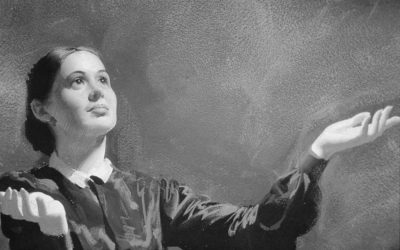Seventh-day Adventist Founders
Early History of the Adventist Movement
While the core beliefs of the Christian religion are straightforward enough, there are numerous denominations within protestant Christianity. What makes the Seventh-day Adventist Church different from any of the others?
Maybe you’ve heard snippets of stories, but you want to know what really happened—how the Adventist church actually began, who was involved with the formation, and why the denomination even exists.
We’ll look at:
- The timeline of significant events of the Adventist church
- Where the name “Seventh-day Adventist” came from
- What Adventists actually believe
- Who were key people in the foundation of the Adventist church
Lots to cover! So, let’s get into it.
Overview timeline of the early Adventist church
 1790—1840: Second Great Awakening in the United States
1790—1840: Second Great Awakening in the United States
1831: War veteran-turned-preacher William Miller deepens his studies and begins preaching about his new discoveries in Scripture
1839: Joseph Bates joins William Miller’s movement, the Millerites, focusing on how the “Second Advent,” or Second Coming of Jesus, is near
1844, Oct. 22: The Great Disappointment—William Miller misinterprets prophetic statements in Daniel and Revelation, thinking Jesus would return on this date.
1845: J.N. Andrews (namesake of Andrews University) accepts Miller’s teachings on the seventh-day Sabbath
1846: Joseph Bates publishes an article on biblical seventh-day Sabbath, which convicts James and Ellen White
1849: James White beings publishing a periodical that’s now called The Adventist Review
1851: Ellen White publishes her first book: A Sketch of the Christian Experience and Views of Ellen G. White
1852: First Adventist printing press is established in Rochester, New York
1855: Biblical research supports the Sabbath timing, beginning sunset Friday and ending sunset Saturday
1860, Oct. 1: Delegates name the denomination “Seventh-day Adventist”
1863: General Conference of Seventh-day Adventists is established
1866: First Adventist-owned & operated medical institution is established
1868: First Adventist camp meeting is held
1872: Opening of first Adventist-sponsored school
1874: Opening of first Adventist college
1874: General Conference launches their Educational Society
1874: J.N. Andrews leaves on his first mission trip to Europe
1879: Adventist membership reaches 16,000
1888: The Great Controversy is first published
1901: Adventist membership reaches 75,000
How Seventh-day Adventism got its name
The name of the Adventist church comes from biblical truths that were forgotten or neglected at the time of its formation. Adventists believed these truths—the seventh-day the Sabbath and the “Second Advent,” or return of Christ to earth—were too foundational to be left out of the common studies of Christians.
After all, if they were important enough to be included in the Bible, they’re important enough to practice.
But how were these truths uncovered?
During the 1790s to late 1830s, the United States experienced a time of religious awakening. The American Revolution helped separate church and state, opening up the doors for anyone to freely study and interpret Scripture. They no longer felt the need to rely on clergy for spiritual direction, or for religion to be intermixed with politics.
As more people studied their Bibles for themselves, many who had drifted away from religion and God became inspired again, and the Second Great Awakening was in full swing.
 Protestants in America had a newfound fervor for God and His word.
Protestants in America had a newfound fervor for God and His word.
And what did they find?
Some biblical truths that had been neglected:
- Christ’s Second Coming will be a literal, visible event, and the church awaits His advent.
- The seventh-day, Saturday, is the Sabbath God established in the beginning.
While other truths were rediscovered, these two are ones the early Adventists were particularly convicted to act upon. After all, belief in these two biblical truths alone could affect a person’s entire lifestyle.
With the belief that Christ could return “any day,” early Adventists began to live more intentionally. They wanted to be prepared for the Second Coming.
One man, William Miller, even believed Christ could return in his lifetime. In fact, through his dedicated study of the Bible and prophecy, he determined the Second Coming would be October 22, 1844.
When morning broke on that day, Miller’s followers (Millerites) were filled with hope and excitement. Come evening, they were discouraged and confused.
How could their friend and leader be wrong? He diligently studied the scriptures and prophecies. Isn’t that why prophecy is in the Bible, to prepare us?
Yes, the Bible gives us prophecy to better understand current and future events. But the Bible also tells us this:
“Concerning that day [Christ’s return] and hour no one knows, not even the angels of heaven, nor the Son, but the Father only” (Matthew 24:36, ESV)
“Therefore you also must be ready, for the Son of Man is coming at an hour you do not expect” (Matthew 24:44, ESV).
Biblical prophecy is complex. It is meant to be a guide for God’s people, but it’s not meant to take the place of God. Total faith in dates, times, and prophecy could mean losing faith in Him.
Luckily, though, Miller did not lose his faith. In fact, it remained extraordinary.
Miller understood he was not wrong to study prophecy in the Bible. He learned his mistake was in predicting the unpredictable.
For Miller’s followers, October 22nd became known as the “Great Disappointment.”
But on October 23rd, Miller and his followers had a choice:
They could give up and go back to their previous denominations, OR they could return to the Bible and continue their search for God’s answers.
A handful of them did the latter and began meeting on Saturdays instead of Sundays.
This was no simple switch. But with fervent study into the meaning of the seventh-day Sabbath, early believers learned of its value, and by 1860 they settled on “Seventh-day Adventism” as the official name. And just three years later, in 1863, they officially organized and established the denomination now led by the General Conference of Seventh-day Adventists.
And that’s only the beginning of what it means to be a Seventh-day Adventist. There’s plenty more, so let’s keep going.
Seventh-day Adventist Believe…
…in the Bible, first and foremost.
Adventists believe the Bible is the spoken word of God, and it is the foundation of the church. Every aspect of the Adventist belief system can be traced back to the Bible, including the Ten Commandments.
The Ten Commandments were given to Moses by God Himself.
After God used Moses to free His people from slavery in Egypt, the people wandered—literally and spiritually.
The Israelites wandered through the desert for years, which—after witnessing God’s miracles in Egypt—was extremely disheartening. But worse than their physical struggles were their spiritual ones.
During their years in the desert, their faith in God slipped. They turned away from Him. They grumbled against God and Moses.
And God heard them.
 To remind the Israelites of His love, God called Moses up to Mount Sinai where He wrote the 10 Commandments. God gave these to Moses as His initiative to establish a loving covenant between God and His people. These were a statement of His standard they needed to return to, especially after years of slavery and tumultuous times. These were the Ten Commandments:
To remind the Israelites of His love, God called Moses up to Mount Sinai where He wrote the 10 Commandments. God gave these to Moses as His initiative to establish a loving covenant between God and His people. These were a statement of His standard they needed to return to, especially after years of slavery and tumultuous times. These were the Ten Commandments:
- Do not have other gods
- Do not worship idols
- Do not speak irreverently of God’s name
- Keep the Sabbath holy
- Honor your parents
- Do not murder
- Be faithful to your spouse
- Do not steal
- Do not lie
- Do not lust for your neighbor’s belongings
And these commandments can be boiled down to this: love. Love God, love one another, and love yourselves.
Based on these biblical commandments, Adventists seek to interpret and apply them in daily practical life. They’ve been set into 28 fundamental beliefs that fall into six main categories: God, Humanity, Salvation, Church, Daily Living, Restoration:
God
- Holy Scriptures
- Trinity
- Father
- Son
- Holy Spirit
Humankind
- Creation
- Nature of humanity
Salvation
- The Great Controversy
- The Life, Death and Resurrection of Christ
- The Experience of Salvation
- Growing in Christ
Church
-
- The Church
- The Remnant and its Mission
- Unity in the Body of Christ
- Baptism
- The Lord’s supper
- Spiritual Gifts and Ministries
- The Gift of Prophecy
- The Law of God
- The Sabbath
- Stewardship
- Christian Behavior
- Marriage and the Family
Restoration
- Christ’s ministry in the Heavenly Sanctuary
Daily Living
- The Second Coming of Christ
- Death and Resurrection
- The Millennium and the End of Sin
- The New Earth
And that’s exactly what the early believers did; they kept the Bible first. And it was the Bible and Holy Spirit that helped guide each person involved in the foundation of the Adventist church.
William Miller opens the door to the Second Advent belief
Initially known as the man who spurred the curiosity surrounding the Second Coming of Christ, William Miller was one of the forerunners of the Advent Movement that eventually birthed the Seventh-day Adventist Church.
Before becoming a devoted Bible scholar, Miller was a deist. After returning from serving in the war of 1812, however, he became anxious at the concepts of death and the afterlife. Fortunately, he turned to the Bible for answers.
While studying his Bible, he learned much more than he ever thought he would . In his memoirs he wrote about how he found Scripture to contain “principle so perfectly adapted to the wants of a fallen world” and that “in Jesus I found a friend.”1
As Miller began to preach and publish information about the Second Advent, however, he and many Millerites were mocked openly and became unwelcome at their former churches.
So they went on to form the Millerite Movement, which focused on the biblical truths they learned from their studies.
For Miller and his followers—the Millerites—the Great Disappointment set them back a bit. But they weren’t going to give up easily.
They dove back into the Bible, back into the prophecy of Daniel. They knew the 2,300 day prophecy meant something, just not the coming of Christ.
Though Miller was wrong about the timing of the Second Coming, it spurred the formation of the Adventist Movement. It was still evident that Jesus was indeed returning to earth, just as He had promised in the Gospels (John 14).
And it was their studies and curiosity that helped establish a church that would continue to prepare themselves and the world for Christ’s return.
Joseph Bates
 Before becoming an Adventist preacher, Joseph Bates spent many years out at sea. His retirement at age 35 came with $11,000—a small fortune at the time and nearly worth $286,000 today.
Before becoming an Adventist preacher, Joseph Bates spent many years out at sea. His retirement at age 35 came with $11,000—a small fortune at the time and nearly worth $286,000 today.
After leaving the sea, Bates found William Miller and his teachings. He began working with Miller to educate people on the biblical truths Miller and his followers discovered. Bates became a successful Millerite preacher, and even through the Great Disappointment, his faith in God didn’t waver.
In fact, he believed in the advent movement so much that he ended up putting his entire life’s savings toward its growth.
In 1846, Bates wrote a piece about the biblical, seventh-day Sabbath. James and Ellen White read his article, and from it, they accepted the belief of Sabbath.
Along with James and Ellen White, Joseph Bates is seen as a co-founder of the Seventh-day Adventist Church.
Ellen G. White
Ellen G. White was a co-founder of the Adventist church and a prolific writer, writing nearly 100,000 pages during her lifetime.
 Without a shadow of doubt, the Bible is the foundation of Adventist faith. And everything Ellen White wrote was to make sure church leadership did not stray from the guidance of Scripture. Through her writings, she sought to help people apply God’s Word to their daily lives in a practical way. She also included general information for how to best live like Christ—no matter what denomination a person claimed.
Without a shadow of doubt, the Bible is the foundation of Adventist faith. And everything Ellen White wrote was to make sure church leadership did not stray from the guidance of Scripture. Through her writings, she sought to help people apply God’s Word to their daily lives in a practical way. She also included general information for how to best live like Christ—no matter what denomination a person claimed.
Together with her husband and Joseph Bates, they helped in the founding and organization of the denomination.
And as the denomination grew, her counsel and insights were very helpful in the leadership, expansion, and establishment of the church and its institutions and missions.
White’s counsels and admonitions were often given as letters, sermons, talks, articles, and books. And all these were documented and compiled into what is known today as the EGW writings. These are managed by the trustees of the EGW Estate, and they remain relevant and of great value to the church.
James White
James White—Ellen’s husband—was integral in the foundation of Adventist institutions.
The first Adventist college, medical institution, and publishing house were all started by him.
James’ personal health issues were what spurred the organization of an Adventist medical system. After receiving medical care while recovering from a stroke, James and his wife realized the help wasn’t what it could be. In response, they established the Battle Creek Sanitarium.2
His first publication was The Present Truth, and it quickly became an effective gospel-spreading method. This periodical later became known as The Adventist Review and still circulates today.
The success the Adventist church has today in various witnessing methods—education, healthcare, and literature—can be attributed to James’ tireless efforts.
J.N. Andrews
At 15, John Nevins Andrews accepted the Seventh-day Adventists beliefs. By age 23, he was an ordained minister of the church.
His own writings supported the writings of Ellen White, and together, they worked to spread the Good News of Christ.
 Andrews dedicated his life to God through his work in the Adventist church. He became a president of the General Conference, an editor of The Adventist Review, and finally, the first Adventist missionary.
Andrews dedicated his life to God through his work in the Adventist church. He became a president of the General Conference, an editor of The Adventist Review, and finally, the first Adventist missionary.
As Adventism spread throughout America, he knew that wasn’t enough.
If Christians were supposed to share the Three Angels’ Message with the whole world, then he needed to just that. So he went to Europe as the first overseas missionary of the Adventist church.
Andrews was inspired to follow the Great Commission Christ spoke to His people:
“Go therefore and make disciples of all nations, baptizing them in the name of the Father and of the Son and of the Holy Spirit, teaching them to observe all that I have commanded you. And behold, I am with you always, to the end of the age” (Matthew 28:19-20, ESV).
Andrews’ mission work not only began the globalization of the Adventist church, but it helped grow the kingdom of God.
Today, Andrews University—the first Adventist university—stands in Berrien Springs, Michigan and was named after J. N. Andrews in recognition for his efforts in the Adventist church.
Where is the Adventist church today?
 Thanks to the work of Andrews, Bates, the Whites, and many more, Adventism flourished all around the world.
Thanks to the work of Andrews, Bates, the Whites, and many more, Adventism flourished all around the world.
In the late 1870s, the church only had 16,000 members.
Twenty years later, in 1901, the worldwide membership count totaled 75,000.
Today, there are more than 20 million members, as well as 8,000 and counting schools, 100+ hospitals, and 50+ publishing houses.
Firmly founded in biblical truths, the Adventist church continues to grow, learn, and share the Gospel with the world. The expansion of the Adventist church hasn’t stopped…and it won’t until Christ returns to take us home.
Want to learn more? Start a personalized online Bible Study!
[2] Archive entry of the noteworthy aspects of Battle Creek Sanitarium https://web.archive.org/web/20110606132412/http://www.mcgi.state.mi.us/hso/sites/3310.htm
More Answers
Ellen G. White’s Travels and Worldwide Mission
Ellen G. White’s Travels and Worldwide MissionThough Ellen White, a co-founder of the Seventh-day Adventist Church, is best known for her ministry in the United States, she also traveled to twelve other countries in her lifetime—a big accomplishment in the 19th...
Ellen G. White’s Time in Europe
Ellen G. White’s Time in EuropeWhen the Seventh-day Adventist Church was still young, a council of the church in Europe requested Ellen White, one of Adventism’s key leaders, to come to Europe. Despite the many obstacles, God led her there to help the new churches and...
What Was Ellen White’s Counsel on Music?
What Was Ellen G. White’s Counsel on Music?At its core, music is a collection of tones, sounds, and rhythms that creates a melody. It’s also much more than that. Like any form of art, it can be profoundly beautiful or deeply dreadful, exciting or depressing, happy or...
Ellen White’s Spiritual Counsel on Marriage
Ellen White’s Spiritual Counsel on MarriageAs one of the founders of the Seventh-day Adventist Church, Ellen G. White was held in high regard. She was a prolific author and was heavily engaged in the mission of the denomination, prayerfully pursuing the guidance of...
Was Everything Ellen White Said Divinely Inspired?
Was Everything Ellen White Said Divinely Inspired?The Seventh-day Adventist Church believes that many of Ellen White’s messages were inspired by God. But that doesn’t mean everything she ever said was prophetic, or meant to be taken as direct instruction from God....
What Ellen White Said About Using the Bible in Education
What Ellen G. White Said About Using the Bible in EducationEllen White, one of the founders of the Seventh-day Adventist Church, believed that education was not complete unless it was founded upon the principles of the Bible. It’s crucial for giving students a...
Ellen G. White’s Counsel on College Education
Ellen G. White’s Counsel on College EducationEllen G. (Harmon) White, a significant co-founder of Adventism, is often known for her practical and spiritual guidance for proper childhood education. But she was also significantly involved in the development of...
What Were Ellen White’s Visions About the Adventist Church?
What Were Ellen White’s Visions About the Adventist Church?Led by the Holy Spirit, Ellen G. White was given many messages, counsel, revelations, and visions about the Bible, history, prophecy, and how we can apply biblical principles to our daily lives. She was also a...
Who Were Ellen White’s Children?
Who Were Ellen White’s Children? Ellen White, who is likely the most well-known co-founder of the Seventh-day Adventist Church, had four children with her husband, James: Henry Nichols, James Edson, William Clarence, and John Herbert. Henry died from pneumonia at the...
Didn’t find your answer? Ask us!
We understand your concern of having questions but not knowing who to ask—we’ve felt it ourselves. When you’re ready to learn more about Adventists, send us a question! We know a thing or two about Adventists.









